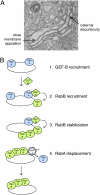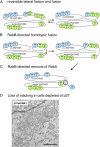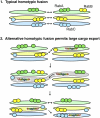How the Golgi works: a cisternal progenitor model
- PMID: 21045128
- PMCID: PMC2993360
- DOI: 10.1073/pnas.1011016107
How the Golgi works: a cisternal progenitor model
Abstract
The Golgi complex is a central processing compartment in the secretory pathway of eukaryotic cells. This essential compartment processes more than 30% of the proteins encoded by the human genome, yet we still do not fully understand how the Golgi is assembled and how proteins pass through it. Recent advances in our understanding of the molecular basis for protein transport through the Golgi and within the endocytic pathway provide clues to how this complex organelle may function and how proteins may be transported through it. Described here is a possible model for transport of cargo through a tightly stacked Golgi that involves continual fusion and fission of stable, "like" subcompartments and provides a mechanism to grow the Golgi complex from a stable progenitor, in an ordered manner.
Conflict of interest statement
The author declares no conflict of interest.
Figures



Similar articles
-
Regulation of Golgi Cisternal Progression by Ypt/Rab GTPases.Dev Cell. 2016 Feb 22;36(4):440-52. doi: 10.1016/j.devcel.2016.01.016. Dev Cell. 2016. PMID: 26906739 Free PMC article.
-
Rab and actomyosin-dependent fission of transport vesicles at the Golgi complex.Nat Cell Biol. 2010 Jul;12(7):645-54. doi: 10.1038/ncb2067. Epub 2010 Jun 20. Nat Cell Biol. 2010. PMID: 20562865
-
Are Rab proteins the link between Golgi organization and membrane trafficking?Cell Mol Life Sci. 2012 Dec;69(24):4093-106. doi: 10.1007/s00018-012-1021-6. Epub 2012 May 13. Cell Mol Life Sci. 2012. PMID: 22581368 Free PMC article. Review.
-
Defining the boundaries: Rab GEFs and GAPs.Proc Natl Acad Sci U S A. 2009 Aug 25;106(34):14185-6. doi: 10.1073/pnas.0907725106. Epub 2009 Aug 19. Proc Natl Acad Sci U S A. 2009. PMID: 19706500 Free PMC article. No abstract available.
-
The yeast Golgi apparatus.Traffic. 2012 Apr;13(4):505-10. doi: 10.1111/j.1600-0854.2011.01316.x. Epub 2011 Dec 27. Traffic. 2012. PMID: 22132734 Review.
Cited by
-
A three-stage model of Golgi structure and function.Histochem Cell Biol. 2013 Sep;140(3):239-49. doi: 10.1007/s00418-013-1128-3. Epub 2013 Jul 24. Histochem Cell Biol. 2013. PMID: 23881164 Free PMC article. Review.
-
Clathrin adaptors mediate two sequential pathways of intra-Golgi recycling.J Cell Biol. 2022 Jan 3;221(1):e202103199. doi: 10.1083/jcb.202103199. Epub 2021 Nov 5. J Cell Biol. 2022. PMID: 34739034 Free PMC article.
-
Sensing Size through Clustering in Non-Equilibrium Membranes and the Control of Membrane-Bound Enzymatic Reactions.PLoS One. 2015 Dec 14;10(12):e0143470. doi: 10.1371/journal.pone.0143470. eCollection 2015. PLoS One. 2015. PMID: 26656912 Free PMC article.
-
Nonequilibrium description of de novo biogenesis and transport through Golgi-like cisternae.Sci Rep. 2016 Dec 19;6:38840. doi: 10.1038/srep38840. Sci Rep. 2016. PMID: 27991496 Free PMC article.
-
Retrograde vesicle transport in the Golgi.Protoplasma. 2012 Oct;249(4):943-55. doi: 10.1007/s00709-011-0361-7. Epub 2011 Dec 12. Protoplasma. 2012. PMID: 22160157 Review.
References
Publication types
MeSH terms
Substances
Grants and funding
LinkOut - more resources
Full Text Sources
Molecular Biology Databases

